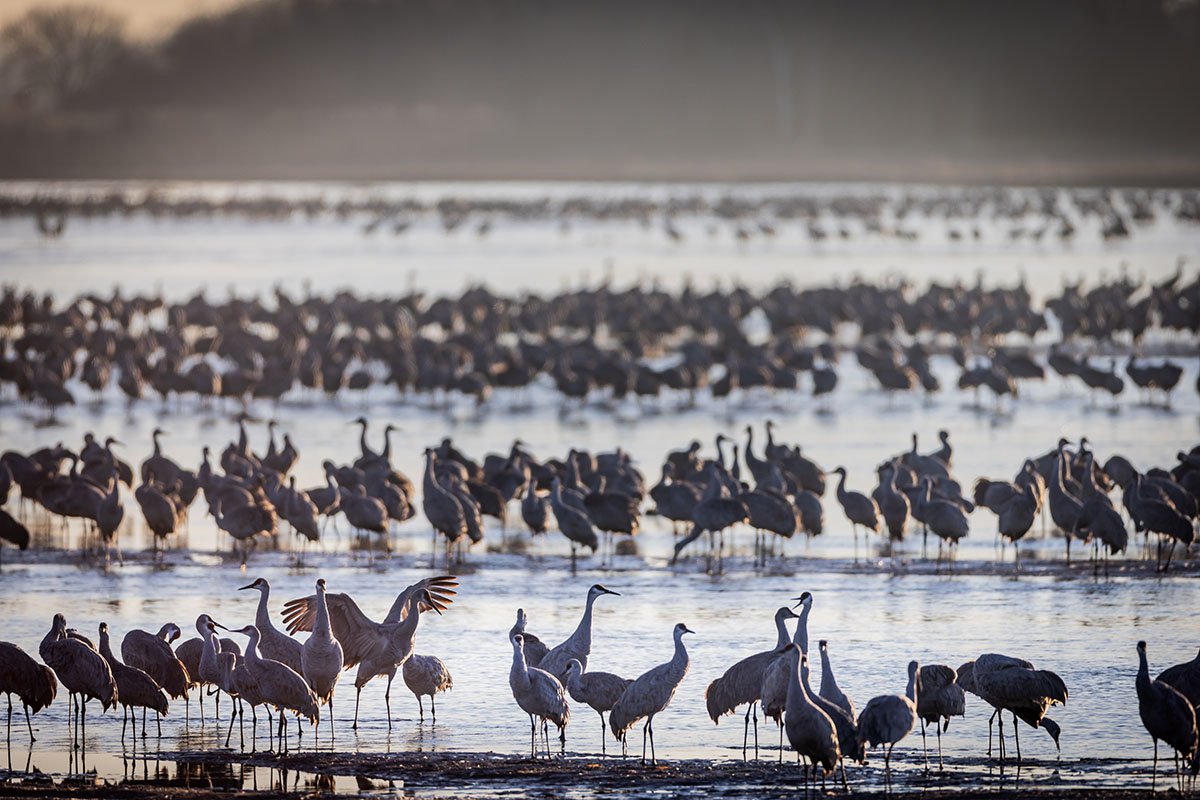They’ve inspired mythology and poets, cultural dances, and even styles of kung fu. Cranes hold important symbolism in cultures around the world, thanks to their fluid movement and smooth flight style. The big birds symbolize joy, happiness, and longevity, and they are often seen as harbingers of great fortune.
For a few more weeks, those good luck charms will crowd into a specific slice of the United States during what experts say is one of the largest and most impressive animal migrations in the world.
In mid-March, the Platte River Valley in Nebraska will be crammed with hundreds of thousands of sandhill cranes each week, as massive flocks make their way from wintering grounds in Texas, New Mexico, and Mexico to Canada, Alaska, and even Siberia, where they’ll spend the summer, nest, and have their babies. Last March, the area saw a peak of nearly 500,000 cranes in a single week.
If you love birds, natural spectacles, and seeing things most people never get to see, this is your chance to plan a last-minute trip to Nebraska (or plan a trip for next year).
Here’s everything you need to know about viewing these birds on their annual migration stopover.
A Centuries-Old Ritual
The cranes are impressive, standing nearly three feet tall, and when in flight, they sport a six-foot wingspan. Sandhills are also incredibly strong, traveling up to 400 miles in one day during their migration. Their rather drab gray-beige feathers are topped by a distinctive scarlet crown, and they emanate a number of different calls as they feed, fly, and flock.
Graceful in flight but goofy and delightfully gangly during courting dances, these birds are characters. And the cranes—more than a million of them—put on a spectacular show throughout March and into early April, pigging out, coupling up, and cavorting during their time in Nebraska.
They’ve gathered here each spring for centuries. In fact, researchers believe the cranes have come to the Platte River since its formation during the last ice age some 12,000 years ago. There are a couple of important reasons why.
“Cranes need safe places to roost overnight and abundant food to stock up for the rest of their migration and early breeding season,” explained Brice Krohn, president/CEO of Crane Trust, a non-profit group dedicated to protecting the cranes’ habitat.
“The Central Platte River Valley in Nebraska has both,” he added. “The wide and shallow channels of the Platte give cranes the proper protection from predators and the space for them to feel safe in numbers. Historically, cranes fed throughout the vast natural wetlands and grasslands surrounding the Platte, eating native seeds, grains, macroinvertebrates, and tubers. However, with the rise in row crop agriculture, the cranes luckily adapted to feeding mostly on waste corn left over from the previous harvest.”
An Ecotourism Boon
An estimated 80% of all sandhill cranes in North America make the 75-mile stretch of Nebraska’s Platte River their spring rest stop, delighting birders from all over the world with their antics. They’ve become a popular ecotourism draw to the otherwise quiet south-central slice of the state.
“We average around 35,000 visitors from late February to mid-April, all hoping to witness different stages of the Central Flyway’s spring migration,” said Krohn. “Visitors travel from across the country and from around the world to witness the spring migration of the sandhill cranes.”
The birds are an important economic boon for the region, as visitors continue to flock there year after year to watch the migration magic. A 2017 study conducted by the University of Nebraska at Kearney estimated the migration’s ecotourism impact at $14.3 million, taking into account costs for lodging, food and drink, shopping, and other factors.
How to Experience the Migration Stopover

Experts say the best sightings occur during the cranes’ massive morning takeoff; during the day when they tend to put on a show with their foraging, mating dances, and other antics; and then again at sunset, when hundreds of thousands return to roost back by the river.
Many visitors center their crane itineraries around roadside sites and state parks, where you can view the birds for free. These include the Fort Kearney Hike-Bike Trail, Buffalo Bill Ranch State Historical Park, Golden Spike Tower and Visitor Center, and the Central Platte Natural Resources District Plautz Viewing Site.
There are two spots that curate special viewing opportunities. First, there’s the Crane Trust, which has a physical location on 5,000 acres along the river. It coordinates pre-dawn and evening blind tours led by guides, plus driving tours.
Crane Trust also provides a luxe experience including overnight onsite accommodation in cozy cottages, access to heated viewing blinds, engagement with Crane Trust staff, catered meals, and even a cocktail hour.
About a half-hour drive away, the National Audubon Society’s Rowe Sanctuary features strategically placed discovery stations along the Platte, giving visitors terrific vantage points. The sanctuary offers guided tours, photography sessions, and its own VIP experience, which gives visitors access to a private blind for the evening. If you stay in the unheated blinds, you are responsible for bringing your own food, drinks, and sleeping gear.
Tips to Make the Most of Your Experience

Most of the area’s best-viewing sites, including Crane Trust and Rowe Sanctuary, are sandwiched between Grand Island and Kearney. The two small cities offer guests an assortment of accommodations and dining options and host most of each season’s out-of-town birders.
Want to take your own crane migration trip this year or next? Here are a few important things to keep in mind:
- Book early if you want to stay the night or for a long weekend. Lodging tends to fill up quickly.
- Dress warmly from head to toe. Temperatures dip below freezing during Nebraska’s early spring, especially at sunrise and sunset when the birds are best seen. Most viewing areas aren’t heated, so plan accordingly.
- Make sure your warm-weather gear is dark colored to keep from disturbing the birds.
- By all means, bring binoculars.
- Crane-spotting can be a great experience for kids, provided they are old enough to give the birds the space and respect they deserve.
- Keep your four-legged friends at home.





